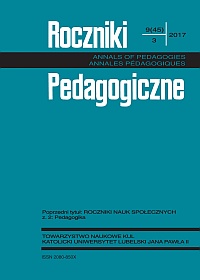The Same Old Seminar in a New Written Format
Main Article Content
Abstrakt
Dawne seminarium w nowej formie pisemnej
Badania przeprowadzone w różnych dziedzinach zawodowych wykazały, że absolwenci szkół wyższych nie posiadają wystarczającej tzw. miękkiej wiedzy i umiejętności zawodowych, zarówno ustnych, jak i pisemnych. Niniejsza działalność badawcza analizuje proces i wyniki uczenia przyszłych nauczycieli przedszkolnych nowego sposobu pisania tekstów. W ramach kontrolowanego projektu 46 absolwentów studiów licencjackich w izraelskim college'u uczestniczyło w dwóch podobnych rocznych seminariach prowadzonych przez autora. Dziesięciu z nich zgłosiło się na ochotnika do grupy eksperymentalnej, która przygotowała swój projekt badawczy w formie profesjonalnie napisanego artykułu. Formuła tekstu była nowoczesna, stosunkowo krótka, tekst napisano prostym językiem, bez żargonu, w przeciwieństwie do artykułów ukazujących się w recenzowanych czasopismach akademickich. Grupa kontrolna, złożona z pozostałych 36 osób, napisała pracę seminaryjną zgodnie z wymogami pisania tekstów akademickich. Porównując zauważone u studentów umiejętności pisania tekstów akademickich w ramach poszczególnych tematów oraz między grupami, przed i po programie nie wykazano istotnych różnic. Wolne wnioski studentów dotyczące jakości pracy wyraziście opisują problemy, z jakimi borykali się oni na początku kursu, oraz satysfakcję, jakiej wszyscy doświadczyli po jego ukończeniu. Te nieoczekiwane wyniki są omawiane, poddaje się krytycznej ocenie uzależnienie od jednego tradycyjnego sposobu pisania tekstów akademickich i podkreśla znaczenie nauczania innych, nowatorskich i bardziej odpowiednich metod pisania tekstów, które spełniają obecne wymogi dotyczące życia zawodowego.
Article Details
Bibliografia
Breeze, R. (2012). Rethinking Academic Writing Pedagogy for The European University. Amsterdam: Brill Academic Publishers, eBook.
Butin, D. (2006). The limits of service-learning in higher education. The Review of Higher Education, 29 (4), 473-498.
Cappelli, P. (2015). Skill gaps, skill shortages, and skill mismatches: Evidence and arguments for the United States. ILR Review, 68 (2), 251-90.
Cheol, S.J., & Teichler, U. (eds.) (2013). The Future of the Post-Massified University at the Crossroads: Restructuring Systems and Functions (Vol. 1). New York: Springer Science & Business Media.
Dysthe, O. (2002). Professors as mediators of academic text cultures: An interview study with advisors and master’s degree students in three disciplines in a Norwegian university. Written Communication, 19 (4), 493-544.
Ellis, R.A., Taylor, C.E., & Drury, H. (2005). Evaluating writing instruction through an investigation of students’ experiences of learning through writing. Instructional Science, (33), 49-71.
Ferrance, E. (2000). Action research. LAB, Northeast and Island Regional Education Laboratory at Brown University.
Firsteter, E. (September 2015). Someone to speak with. Hed Hagan, 80 (1), 56-63.
Flesch, R. (1948). A new readability yardstick. Journal of Applied Psychology, (32), 221-223.
Greene, S. (1993). The role of task in the development of academic thinking through reading and writing in a college history course. Research in the Teaching of English, 27 (1), 46-75.
Hartley, J. (2008). Academic Writing and Publishing. London: Routledge.
Hartley, J., Sotto, E., & Fox, C. (2004). Clarity across the disciplines: An analysis of texts in the sciences, social sciences and arts and humanities. Science Communication, 26 (2), 188-210.
Jackson, D., & Chapman, E. (2012). Non-technical skill gaps in Australian business graduates. Education + Training, 54 (2-3), 95-113.
Jackson, K., Lower, C., & Rudman, W. (2016). The crossroads between workforce and education. Perspectives in Health Information Management, 5 (1), 1-11.
Kavanagh, M. H., & Drennan, L. (2008). What skills and attributes does an accounting graduate need? Evidence from student perceptions and employer expectations. Accounting & Finance, 48 (2), 279-300.
Kolb, A., Kolb, D. (2005). Learning styles and learning spaces: Enhancing experiential learning in higher education. Academy of Management Learning & Education, 4 (2), 193-212.
Luey, B. (2002). Handbook for Academic Authors (fourth ed.). Cambridge: Cambridge University Press.
Lumpkin, A. (2015). Enhancing undergraduate students’ research and writing. International Journal of Teaching and Learning in Higher Education, 27 (1), 130-142.
Manykia, J., Chui, M., Brown, B., Bughin, J., Dobbs, R., Roxburgh, C., and Hung-Beyers, A. (2011). Big Data: The Next Frontier for Innovation, Competition, and Productivity. McKinsey Global Institute. Available at http://www.mckinsey.com/insights/ business_technology/big_data_the_next_frontier_for_ innovation.
National union of Israeli students (August 2016). The committee for renovating the Israeli higher educational system: A report and recommendations. http://www.nuis. co.il/wp-content/uploads/2016/08/DOH-VAADA.pdf
Nygaard, L.P. (2009). Writing for Scholars: A Practical Guide to Making Sense and Being Heard. Copenhagen, DK: Copenhagen Business School Press.
Strongman, L. (2013). Academic Writing. Newcastle upon Tyne: Cambridge Scholars Publishing. eBook.
Vygotsky, L.S. (1980). Mind in Society: The Development of Higher Psychological Processes. Harvard University Press.
Yariv, E. (29.7.2010). Modeling academic writing within a ‘master-class’ format, First International Conference on Academic Writing, The Mofet Institute, Tel Aviv, Israel.
Yu, S., Churyk, N.T. & Chang, A. (2013). Are students ready for their future accounting careers? Insights from observed perception gaps among employers, interns, and alumni. Global Perspectives on Accounting Education, 10 (2), 1-15.
